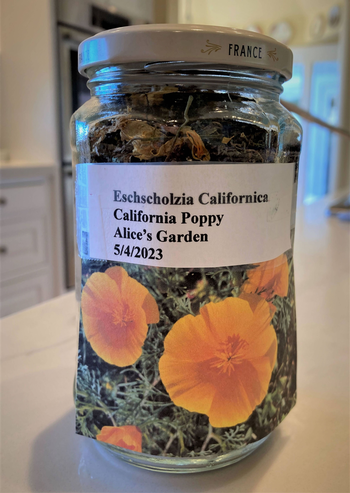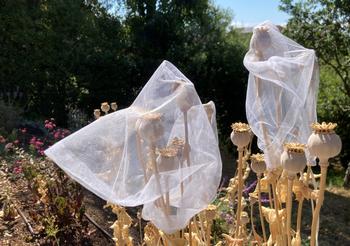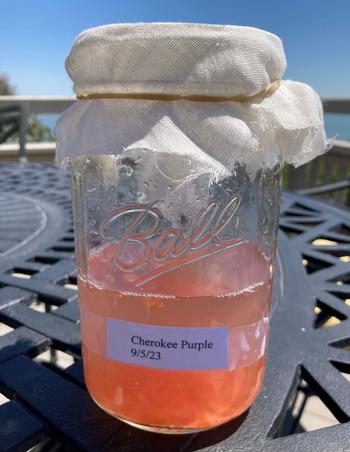Saving seeds: select, collect, store, and share
-
Alice Cason
-
Generations of Indigenous peoples worldwide worked for thousands of years with wild plants to produce the foods that sustain us today. Seed is the first link in the food chain, a 10,000-year-old tradition that enhances biodiversity. Seeds serve as food for humans and many species of insects and animals. There are tiny seeds like those of the orchid, which weigh .01mg, and the large double Seychelle coconut weighing 24kg. Seeds travel in surprising ways. Some glide through the wind on elegant floss (Milkweeds), and some float on the sea (Coconuts). Some entice animals to spread their seeds wrapped in tasty fruit.
 A recycled jar is a great container for California Poppy Seeds. I put a photo on the label (with genus, species and date) so I can see what is inside.
A recycled jar is a great container for California Poppy Seeds. I put a photo on the label (with genus, species and date) so I can see what is inside.Today, a growing movement encourages us to grow Heirlooms, plants passed down from generation to generation, valued for unique traits, flavors, and historical significance. Heirloom plants are Open Pollinated plants pollinated by insects, wind, or natural means. They exchange pollen between the same variety, so the plants resemble the parent plants. They are “True to Type” and suitable for seed saving.
Not suited to seed saving are Cross-Pollinated plants and Hybrids. These are the result of pollen from one plant transferred to the flowers of another plant. This can happen with insects, birds, or human intervention. Hybrids are often created to combine the best features of two plants, such as disease resistance. However, these seeds lack stability and may not produce plants identical to the parent.
At the Seed Savers Exchange in Decorah, Iowa, they maintain over 20,000 varieties of seeds. Some 700+ varieties are commercially available to the public in the organization’s seed catalog. The revenue from the seed sales, donations, and memberships promote and encourage the tradition of saving and sharing seeds.
All those seeds are stored at the Svalbard Global Seed Vault in Norway, established in 2008. Inside a tunnel with a temperature of -18 degrees Celsius, warehouses have been dug into a mountain to store specimens of global plant species grown today and those no longer found in Nature. Seed banks ensure there is always a chance to recover lost species and find new ones resistant to disease. Small net bags prevent seeds from floating away on the wind. Preserve the seeds in paper envelopes or glass jars.
Small net bags prevent seeds from floating away on the wind. Preserve the seeds in paper envelopes or glass jars.Collect seeds from healthy, vigorous, disease-free plants. This can be as easy as picking them off the ground (acorns), bagging them with a net bag (lettuce), collecting seed heads in a paper bag (California poppies), or saving the seed pods (peas). Keep track of what you have. Label with the genus and species, the color of the flowers, and the date collected. The main enemy of seeds is moisture. Please make sure the seeds are completely dry before putting them in paper envelopes or glass jars.
Tomato seeds need an extra step: fermentation. It replicates what would happen if the fruit dropped to the ground—the first harvest of ripe and juicy fruit. Squeeze the seeds into a jar or cup and cover with cheesecloth or screen. Add some water and let it ferment for a few days until a smelly surface mold forms. Strain that off and rinse the seeds that have fallen to the bottom. Spread them out onto a paper plate and let them dry for up to 4 weeks. The seeds will be viable for up to 4 years. Fermenting tomato seeds will form mold in 3-4 days. Remove the layer of mold & bad seeds and rinse good seeds at the bottom of the jar.
Fermenting tomato seeds will form mold in 3-4 days. Remove the layer of mold & bad seeds and rinse good seeds at the bottom of the jar.Seed saving preserves plant diversity and promotes a tradition of sharing and community. By sharing your seeds with friends, neighbors, or your local library program, you contribute to the collective effort of preserving biodiversity and ensuring a sustainable future for our planet. You are passing along a legacy of knowledge, culture, and resilience. Along with the joy of sharing with others, you can look forward to the rewards of planting your seeds in the spring.
For more information on saving specific seeds, see Seed Saving - UC Marin Master Gardeners (ucanr.edu).
Photo credits: Alice Cason



